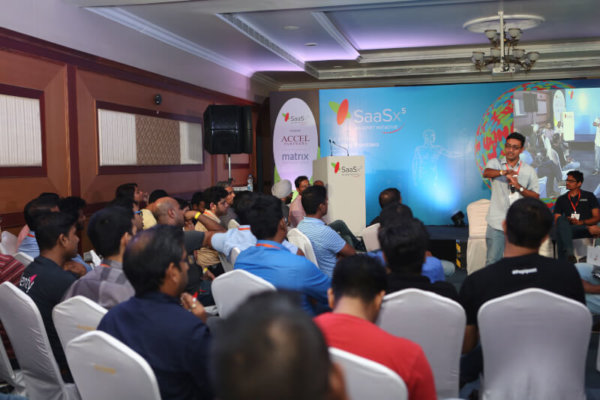As a first time attendee of iSPIRT‘s annual SaaSx conference, I didn’t know what to expect as we drove along the western coast of India towards Mahabalipuram – the venue for SaaSx5. From all the chatter around the event on Twitter, it looked like the who’s who of SaaS leaders in India were attending. Upon arrival, I took my seat with my colleague and looked around. There were only about 100 people in the room, very different from most conferences I’d attended in the past – a lot more exclusive, and a melting pot of SaaS founders building a diverse set of products. It had all the markings of an inspiring day, and it did not disappoint.
Starting with a keynote from the estimable founder of Zoho, Sridhar Vembu, the day was packed with talks and discussions focused on growing one’s SaaS company in the current technology landscape, primarily led by founders of notable SaaS companies of the country. One such event was an unconference on “Setting up and Scaling Sales across Segments and Geographies”, led by Ashwin Ramasamy from PipeCandy.
Picture this: about 80 founders seated in a room, circled around Ashwin who was leading the conversation about setting up and scaling your sales team. Since the flat organizational hierarchy at SignEasy, and the culture of openness at the company provide me with a wonderful vantage point of all functions across our company, including sales, I was eager to listen to the different perspectives that the founders brought to the table. At the start of the discussion, Ashwin graciously asked the audience for talking points they’d like covered, and the discussion began. A plethora of topics were discussed, starting from the very definition of inside sales, leading up to when and why to deploy an inside-sales team. Hiring and putting together the right sales team, including whether it should be in-house or outsourced, was another hot topic of debate with many founders offering their own experiences and perceptions.

The conversation then steered towards outbound sales and the mechanics and economics of that, which contributed to some of the biggest takeaways for me – things that cannot be found in a book and are only learned through experience.
The success rate of outbound sales peaks at 2%, as opposed to the 40-50% success rate you come to expect with inbound sales. This was an interesting insight, as it’s easy to assume your outbound effort is underperforming when it could actually be doing quite well. Also, you should use the interest you’re receiving through the inbound channel to refine your outbound strategy – your inbound interests are a goldmine of information on the kind of industries, company sizes, and job functions your potential customers represent. At SignEasy, we are constantly honing our outbound target by capturing as much information as possible from our inbound requests.

Further, the efficacy of your outbound sales effort is a direct function of the maturity of the market you’re in – for a saturated market with tens of other competitors, outbound usually fails to make a mark because it’s difficult to grab a potential customer’s attention. This is a great rule of thumb to decide if outbound is for you, depending on the market your product serves.
Outbound sales also requires dedicated effort rather than a ‘spray and pray approach’ – a minimum 6-month commitment is crucial to the success of your outbound strategy. Founders should be deeply involved in this initial effort, sending out 500 emails a day for at least 3 months, and tweaking and iterating through them as they get to the most effective email. It’s also important to dedicate yourself to a channel when experimenting, but also experiment and exhaust numerous channels over time to zero in on the most effective ones.

The value of this discussion, and indeed the day, was best expressed by the ferocity with which my colleague and I took notes and wrote down every piece of advice that was being dropped around the room. Being product leads of the SMB business and mobile products respectively, Phalgun and I were amazed at how much we could relate to each point being discussed, having been through and living the journey first-hand ourselves at SignEasy.
SaaSx5 was nothing short of inspiring, and we emerged from it feeling uber-optimistic about SaaS in India, and what the future holds
This blog is authored by Apoorva Tyagi, Product at SignEasy




